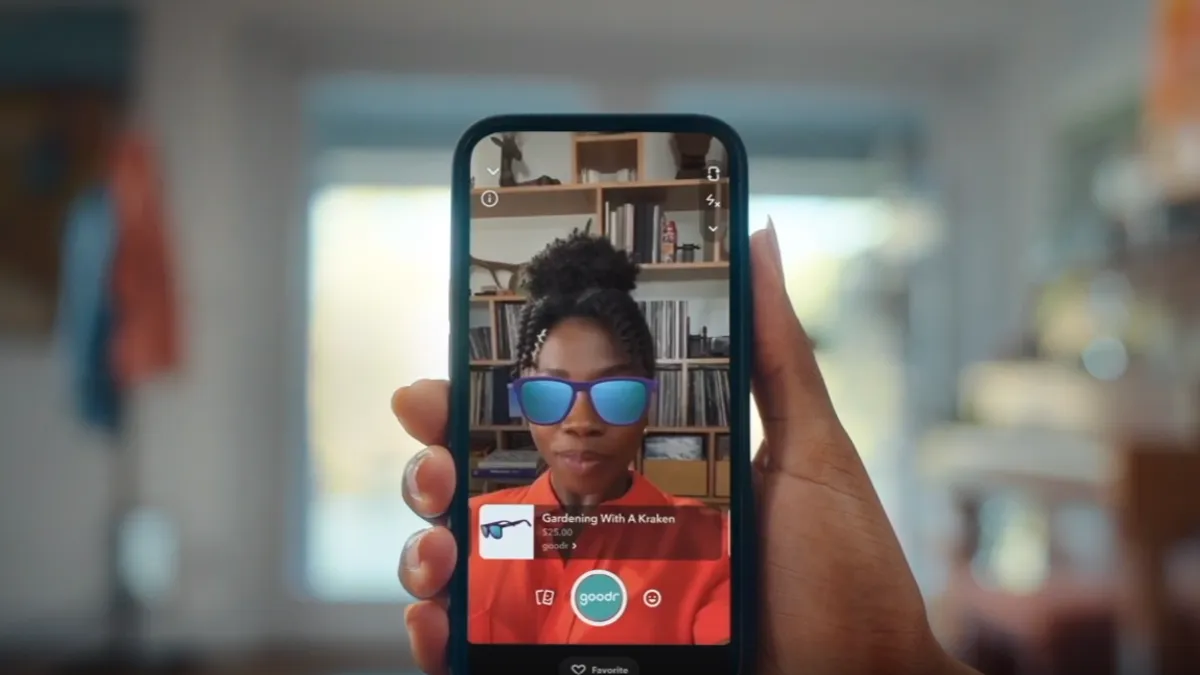The Snap Partner Summit in late April showcased a variety of features that expand the e-commerce capabilities of Snapchat, the photo-messaging app that’s especially popular with younger consumers. New software tools to create augmented reality (AR) shopping content give brands another way to engage mobile users and guide them toward a purchase.
The company highlighted how sportswear brand Puma, sunglasses maker Goodr, fashion retailer American Eagle Outfitters and eyewear company Zenni Optical use Snap AR Shopping to offer virtual try-ons of their products on Snapchat and their own apps. A new in-app feature called Dress Up brings together those fashion try-ons, giving users a place to experiment with new looks and share them with friends before making a purchase. The feature is available to consumers in Snapchat’s Lens Explorer.
“For the first time, you can try on a new outfit without having to change your clothes,” Carolina Arguelles Navas, head of AR business strategy at Snap, said in the presentation. “Ultimately, we’re going from ‘this looks good’ to ‘this looks good on me.’”
The new feature guides users through the process of taking a full-body picture of themselves while fully clothed. Computer vision technology analyzes the image and overlays digital renderings of apparel in different poses, aiming to help consumers make a more informed purchase decision. More than 250 million Snapchatters have used AR Shopping Lenses since January 2021, leading to more than 5 billion total engagements, according to Snap.
Puma is the first global brand to use the technology, letting customers virtually try on its sneakers by pointing a smartphone camera at their feet. After selecting the style and color, shoppers can go straight to the checkout to place an order for delivery, as Snap demonstrated during the presentation.
To highlight the effectiveness of AR, Snap’s Arguelles Navas pointed to Zenni Optical, which lets mobile shoppers try on different styles of glasses. People on the app have tried on the brand’s AR Lenses more than 60 million times, per Snap data. In addition, the Lenses that included Snap's "true size" technology drove a 42% higher return on ad spend (ROAS) than for Lenses without the feature.
Social commerce growth
Snap is among the social media companies that have worked to build out their commerce functionality to help advertisers bring consumers closer to purchase. Facebook, TikTok, Instagram, Pinterest and Twitter also are seeking a piece of the growing social commerce market, whose U.S. sales are forecast to expand from $45.7 billion this year to almost $80 billion by 2025, per eMarketer.
“Snapchat is immersed in the battle for share of social commerce wallet, as they — and other social media companies — continue introducing new ways to transact on their platforms,” Kelsey Chickering, principal analyst at Forrester, said in an email to Marketing Dive. “Leaning into AR use cases related to shopping, such as virtual try-on, uniquely positions Snapchat compared to other social platforms in the commerce space.”
The percentage of U.S. online adults younger than 25 who said they had completed a purchase on a social network without leaving the website or app rose from 53% in 2020 to 61% last year, Forrester found in a survey. This suggests there is a growing appetite among younger consumers to shop while browsing their preferred social platforms.
TikTok signaled its intention to make AR a bigger part of its offering with its recent integration of Camera IQ's tools so brands can easily create AR effects. However, commerce isn't part of the Camera IQ features, TikTok has been making waves in social commerce since jumping into the space last summer.
Improving AR workflows for fashion brands
Merchants that add AR content to their stores see an average gain in conversions of 94%, according to e-commerce software company Shopify. However, creating 3D models for AR can be a time-consuming process, especially for fashion brands and retailers with thousands of items in different styles and colors. To help brands and their creative agencies with those workflows, Snap introduced the new 3D Asset Manager. The software tools include AR Image Processing Technology, which lets select apparel brands repurpose product images they already have in their catalogs to more easily create AR try-on lenses, according to the company.
“Leaning into AR use cases related to shopping, such as virtual try-on, uniquely positions Snapchat compared to other social platforms in the commerce space.”

Kelsey Chickering
Principal analyst, Forrester
Snap added a selection of AR Shopping templates in Lens Web Builder, its self-service platform for creating digital imagery that consumers use to decorate photos and videos. The templates are free for brands that import AR assets to create shoppable virtual try-on and product visualization lenses.
Snap also expanded its tools for software developers to help them add AR features to their apps. With the new Camera Kit for AR Shopping, third-party apps can add AR try-on and product visualization technology. The feature is now available for iOS and Android apps, and will soon be available for websites, Arguelles Navas said in the presentation.
'Measurable business results'
For Snap, the introduction of AR shopping tools comes as the company seeks to build on relationships with its growing user base, which expanded 18% from a year ago to reach 332 million people by the end of 2022's first quarter. AR is one of the most popular features in Snapchat. More than 250 million users engage with AR features on a daily basis, and content creators have built more than 2.5 million Lenses, according to the company.
“In the past, larger brands used augmented reality for brand moments to drive awareness and reach through expensive one-day takeover Lenses,” Jeremi Gorman, Snap's chief business officer, said in prepared remarks for the earnings announcement. “Today, both brand and performance-oriented advertisers are utilizing augmented reality to drive significant and measurable business results.”






















